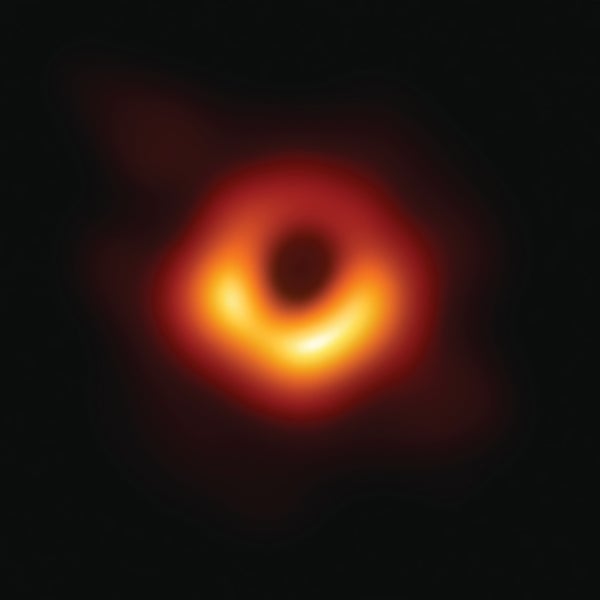It actually worked.
The Event Horizon Telescope (EHT) has always sounded like an unlikely proposition: create a virtual Earth-size telescope to take a picture of the shadow of a black hole. Every piece of that sentence is a little bit absurd.
But it worked. After more than a decade of technical development and fundraising and astronomer herding and telescope wrangling, the astronomers of the EHT unveiled the first picture of a black hole—a bubble of pure gravity, a hole in spacetime, a prediction of general relativity so strange that Albert Einstein himself long refused to believe the concept was possible.
On supporting science journalism
If you're enjoying this article, consider supporting our award-winning journalism by subscribing. By purchasing a subscription you are helping to ensure the future of impactful stories about the discoveries and ideas shaping our world today.
In six simultaneous press conferences on four continents, astronomers lit up projection screens with an image that, for experts at least, is unmistakable: a dark circle surrounded by a ring of light and lopsided fiery blobs, clumps of matter heated to 100 million degrees and circling the black hole at close to the speed of light.
Technically, this is a picture of the shadow of a black hole: specifically, a supermassive black hole—a 6.5-billion-solar-mass beast—55 million light-years from Earth at the center of the galaxy Messier 87. Black holes trap everything that falls in, including light, which is why they are black. In a sense, they are fundamentally unseeable, one-way cosmic escape hatches leading to ... well, that part is unclear. But because of the way they warp spacetime, they impose a dark silhouette on the glowing, superheated matter that circles them. This is the barely imaginable scene the EHT captured during an observing run almost four years ago and revealed to the world two years later.
Since the 1960s, when indirect astronomical evidence and breakthroughs in theoretical physics made the existence of black holes all but undeniable, these objects have been in a kind of epistemological limbo: they were the most likely explanation for all sorts of otherwise inexplicable phenomena, but no one held out much hope of ever seeing one.
That changed in the late 1990s, when astronomers around the world began building powerful high-frequency radio observatories on high ground in Hawaii, Mexico, Chile and the South Pole. Theoretical astrophysicists calculated that, in theory, uniting these telescopes using a technique called very-long-baseline interferometry would allow them to see the shadows of supermassive black holes that were sufficiently huge and close to Earth. The biggest prize has always been Sagittarius A*, the four-million-solar-mass black hole at the Milky Way’s center. Sagittarius A* remains unseen—at least by the public. But M87, the only other known black hole within the EHT’s grasp, has been captured.
Usually big scientific discoveries like this leak early, but this time the astronomers kept surprisingly tight control. France Córdova, director of the National Science Foundation—which has invested more than $28 million in the EHT over the years—saw the image for the first time at the press conference on the morning of April 10, 2019. It moved her to tears.
The NSF and other funding institutions promised that the EHT’s result would be “groundbreaking,” and it certainly was—the first direct evidence for the existence of event horizons, the defining feature of a black hole. But anyone hoping that this image would chip away at Einstein’s ironclad theory of general relativity came away disappointed: the black hole looks pretty much exactly like the century-old theory says it should.
But this photograph is only a start. Since the 2017 observation, the EHT array has already grown in size and acuity, with a new telescope joining and another on the way and with the installation of ever more powerful digital-signal-processing hardware at each site. As Sera Markoff, an astrophysicist at the University of Amsterdam, said at the press conference, in the future all kinds of new telescopes will join the EHT to observe M87, Sagittarius A* and other black holes simultaneously in many different bands of light—radio, x-ray, gamma ray, infrared and optical.
It’s also worth noting that in the two hours after the press conference, at least six scientific papers on the observation appeared online. They almost certainly contain clues and new questions that will take more time to process than a 24/7 news cycle can tolerate. For now, though, it’s worth pausing for a moment to consider the strangeness of nature and the remarkable fact that these sentient, tool-using bipeds on a small world in a backwater solar system somehow managed to turn their planet into a telescope and take a picture of an exit chute from the universe.

